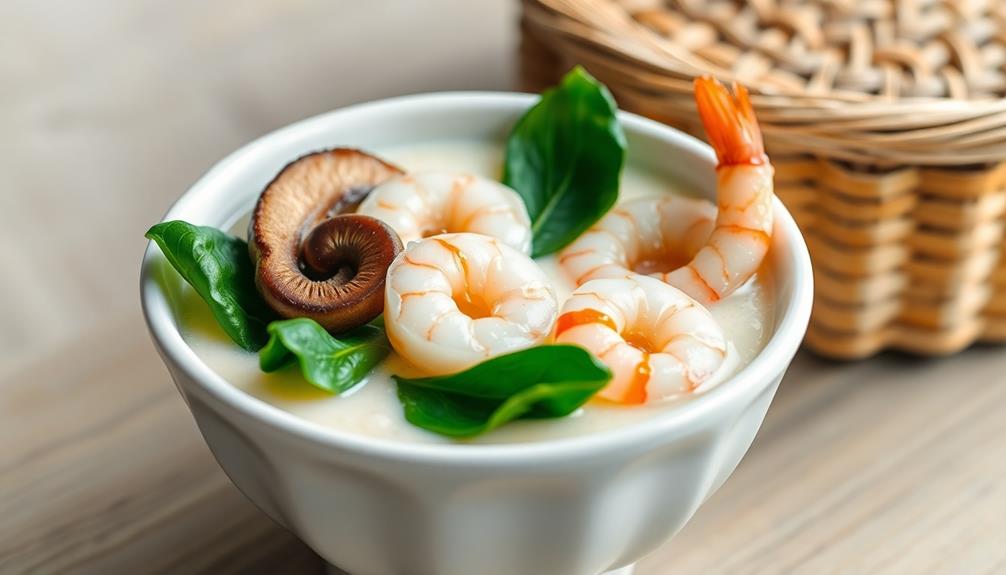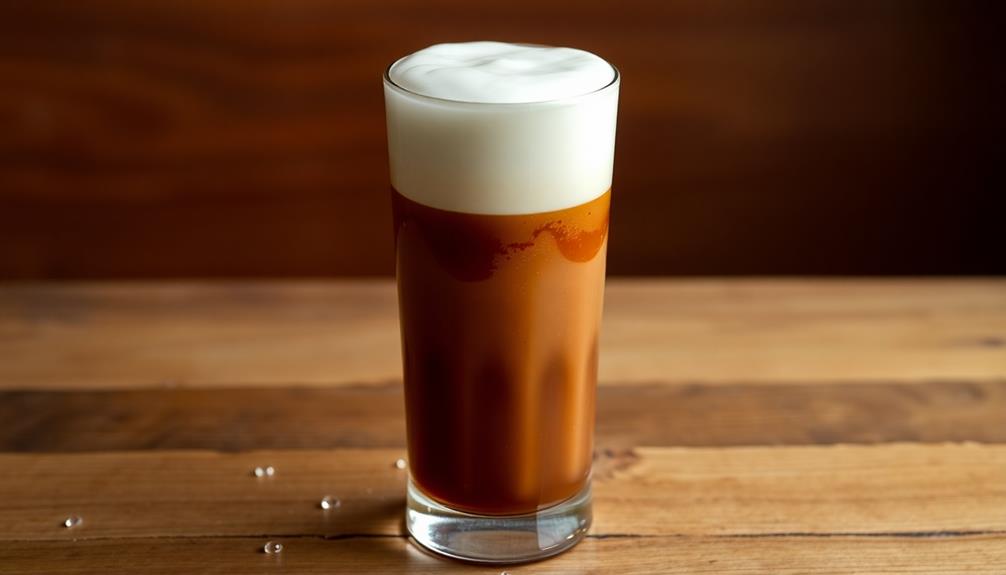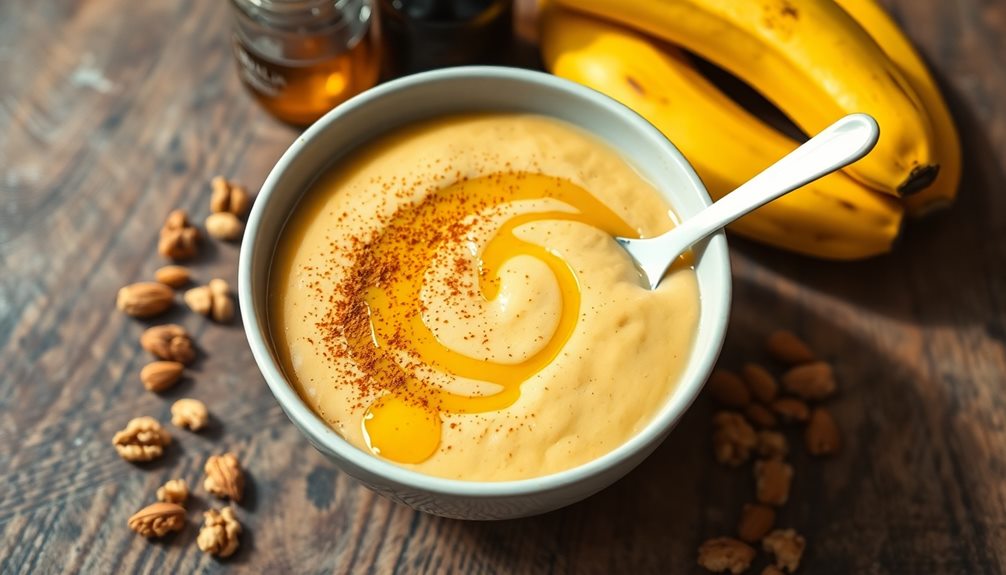Bread pudding's origins can be traced back to 11th century Europe, when resourceful cooks used stale bread, milk, and simple ingredients to create a comforting dessert. Over time, this thrifty dish evolved, incorporating eggs, sugar, and fragrant spices. Today, bread pudding remains a beloved treat, with its soft, custardy interior and golden-brown top. To make it, you'll soak bread in a milk mixture, then bake it until set. Don't forget to finish with a dusting of powdered sugar – it's the perfect finishing touch that enhances the pudding's warmth and flavors. Once you've tried this classic, you'll understand why bread pudding has been a favorite for centuries. Continue reading to discover the full recipe and cooking steps.
Key Takeaways
- Bread pudding has European origins dating back to the 11th century, with early versions using stale bread soaked in milk or cream.
- The classic recipe evolved to include eggs, sugar, and spices like cinnamon and nutmeg, making it a popular comfort dessert.
- The cooking process involves soaking the bread in a milk-egg mixture, then baking until the center is set and the top is golden brown.
- Bread pudding is versatile, allowing for customizations with toppings like powdered sugar, whipped cream, or caramel sauce.
- The dish offers a balance of flavors and textures, making it a comforting treat suitable for any season.
History
The origins of bread pudding can be traced back centuries, with early versions of the dish appearing in Europe as early as the 11th century.
Back then, thrifty cooks would repurpose stale bread, soaking it in milk or cream and baking it into a warm, comforting treat.
Over time, the recipe evolved, with the addition of eggs, sugar, and spices like cinnamon or nutmeg.
Cooking Steps
Preheat your oven to 350°F (175°C) and grease a 9×13-inch baking dish.
In a large bowl, tear the bread into bite-sized pieces. Pour the milk over the bread and let it soak for 10 minutes, stirring occasionally, until the bread is soft and has absorbed most of the milk.
In another bowl, whisk together the eggs, sugar, vanilla, cinnamon, and a pinch of salt.
Gently fold the egg mixture into the soaked bread. Pour the bread pudding batter into the prepared baking dish. Sprinkle the top with the raisins.
Bake for 45-50 minutes, or until the center is set and the top is golden brown.
Let the bread pudding cool for 15 minutes before serving. Scoop into bowls and enjoy this comforting, custardy dessert.
You can serve it warm, at room temperature, or even chilled, depending on your preference.
Step 1. Soak Bread in Milk Mixture

Next, you'll want to soak the bread in the milk mixture. Grab the torn or cubed bread you prepared earlier and gently place it into the bowl with the warm milk, eggs, sugar, vanilla, and spices.
Use your hands to ensure all the bread is submerged and soaking up the delicious mixture. Let it sit for about 30 minutes, giving the bread time to absorb all those yummy flavors.
As the bread soaks, it will become soft and plump, ready to transform into a decadent bread pudding. You'll know it's ready when the bread has expanded and the mixture has thickened slightly.
Be careful not to let it soak for too long, or the bread may become mushy. Once the bread is perfectly saturated, you can move on to the next step of assembling your bread pudding.
Step 2. Add Egg Mixture

Once the bread has finished soaking, add the egg mixture to the bowl. Crack a few eggs into a separate bowl and beat them well.
Then, pour the beaten eggs right into the bread and milk mixture. Use a spoon to gently stir everything together until the eggs are fully incorporated. You'll see the mixture start to thicken up as the eggs cook. This is exactly what you want!
The eggs help bind the bread pudding together, creating a creamy, custard-like texture. Keep stirring and folding the ingredients until they're nicely combined. Don't be afraid to really get in there with your spoon. You want every bite to have that rich, eggy flavor.
Once the egg mixture is fully incorporated, you're ready for the next step. Preheat your oven and get ready to bake this delicious bread pudding to perfection!
Step 3. Pour Mixture Into Baking Dish

Pour the bread and egg mixture into a greased baking dish. Make sure to spread it out evenly, so it bakes up nice and fluffy. You want the top to be golden brown and the inside to be moist and delicious.
Now, gently tap the dish on the counter a few times to help the mixture settle and release any air bubbles. This will ensure your bread pudding has a smooth, even texture.
Once it's all settled, you can top it with a sprinkle of cinnamon or a handful of raisins, if you like.
Carefully place the baking dish in the preheated oven. Set a timer so you don't forget about it.
In about 45 minutes to an hour, your bread pudding will be ready. The house will smell amazing, and you'll be so excited to dig in. Just remember to let it cool for a few minutes before serving. That way, you don't burn your mouth on the first bite!
Step 4. Bake at 350°F Until Set

Bake the bread pudding at 350°F for 45 minutes to an hour, or until a knife inserted in the center comes out clean. This is the key step to turning your delectable mixture into a perfectly baked dessert.
Keep a close eye on it, as ovens can vary, and you don't want to end up with a dry, crumbly mess. The bread pudding should be golden brown on top and firm to the touch when it's done. If the center is still jiggly, give it a few more minutes.
Once the pudding is set, let it cool for 10-15 minutes before serving. This allows the flavors to meld and the texture to firm up.
Serve warm, perhaps with a dollop of whipped cream or a drizzle of caramel sauce. Your family and friends will be wowed by this homemade treat. Enjoy!
Step 5. Sprinkle With Powdered Sugar

After the bread pudding has finished baking and cooled for 10-15 minutes, sprinkle a light dusting of powdered sugar over the top. This simple step adds a delightful touch of sweetness and visual appeal to your freshly baked creation.
Gently shake the powdered sugar over the surface, making sure to cover the entire top evenly. The soft, billowy white sugar will create a lovely contrast against the golden-brown bread pudding. As you sprinkle, you'll notice the sugar lightly settling into all the nooks and crannies, giving the dish a tempting, homemade look.
Once you've achieved an even coating, step back and admire your handiwork. The powdered sugar not only enhances the flavor but also lends a charming, rustic aesthetic to the bread pudding.
Now, it's ready to be served and enjoyed by family and friends. The sweet dusting will melt deliciously on the tongue, completing the perfect bite of this comforting dessert.
Final Thoughts
Bread pudding is a delightful and versatile dessert that can be enjoyed any time of year.
Whether you prefer it warm, chilled, or at room temperature, this classic dish is sure to satisfy your sweet tooth.
The final step in preparing your bread pudding is to let your creativity shine.
Sprinkle on a dusting of powdered sugar or drizzle with a decadent caramel sauce for an extra touch of sweetness.
You can even experiment with different toppings, like fresh berries or a dollop of whipped cream, to make each bite unique.
The beauty of bread pudding is that it's endlessly customizable to suit your personal taste.
So, go ahead and indulge in this comforting treat – your taste buds will thank you.
With its perfect balance of flavors and textures, bread pudding is a dessert you'll want to enjoy again and again.
Frequently Asked Questions
Can Bread Pudding Be Made With Stale Bread?
You sure can make bread pudding with stale bread! In fact, stale bread works great for this dish. It soaks up all the delicious custard mixture, resulting in a rich, decadent dessert.
Don't let that stale bread go to waste – turn it into something amazing! With just a few simple ingredients, you can transform it into a cozy, comforting bread pudding.
Give it a try, and you'll be amazed at how delicious it turns out.
How Long Does Bread Pudding Need to Chill Before Serving?
Chilling bread pudding before serving is a must!
After baking, you'll want to let it cool completely, then pop it in the fridge for at least 2-3 hours.
This allows the flavors to meld and the texture to firm up, so you get that perfect, creamy, custardy bite.
Don't be tempted to dig in right away – the wait will be so worth it when you take that first, heavenly spoonful!
Can Bread Pudding Be Frozen for Later Use?
Yes, you can definitely freeze bread pudding for later use!
Just let it cool completely, then wrap it tightly in plastic wrap or foil.
When you're ready to enjoy it, simply thaw it in the fridge overnight and then reheat it in the oven until it's warm and delicious.
Freezing bread pudding is a great way to save time and enjoy a homemade treat whenever you want.
Give it a try – you'll be glad you did!
What Is the Best Way to Reheat Leftover Bread Pudding?
Reheating leftover bread pudding is a breeze! The best way is to pop it in the oven at 325°F for about 10-15 minutes. This will warm it up perfectly without drying it out.
You can also microwave it in 30-second intervals, stirring between each, until it's heated through. Just be careful not to overheat it, or the texture might get a little funky.
Either way, you'll have delicious, warm bread pudding in no time!
Can I Use Different Types of Bread in Bread Pudding?
You can absolutely use different types of bread in your bread pudding!
In fact, it's a great way to get creative and use up any leftover bread you have. From crusty French bread to soft sandwich bread, each type will give your pudding a unique texture and flavor. Don’t be afraid to experiment with different types of bread to see which one you like best. And if you’re looking for a twist on the classic bread pudding, try using cinnamon raisin bread or even croissants for a decadent treat. It’s also worth mentioning that using stale bread is ideal for absorbing the custard mixture, similar to a classic french toast recipe.
Feel free to mix and match – the possibilities are endless! Just be sure to adjust the amount of custard to accommodate the different bread types.
Have fun experimenting and making your bread pudding extra special.










